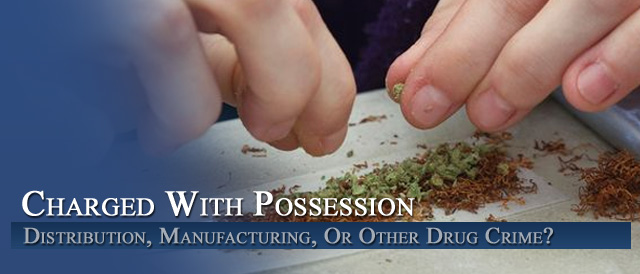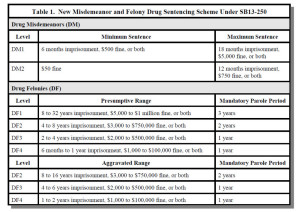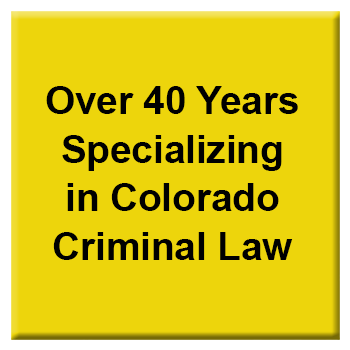




Understanding Colorado’s Special Offender Law C.R.S. 18-18-407
By H. Michael Steinberg Colorado Drug Crimes Criminal Defense Lawyer
Understanding Colorado’s Special Offender Law C.R.S. 18-18-407 – The Special Offender designation on a Colorado drug crimes charging document means a heavier sentence upon conviction. To fully understand this complex aspect of Colorado criminal law – you need to understand how and why Colorado State District Attorney’s charge and prove cases.
As in all aspects of Colorado law – I always recommend studying the law itself. In this area, the Colorado law that applies is, Colorado’s (Drug) Special Offender Law 18-18-407
A Summary List For Colorado Drug Felony Special Offenders
A defendant is required to be designated a special offender if he or she:
• was previously convicted of two ore more offenses which were punishable by one year or more of imprisonment and involved the manufacture, sale, dispensing, or distribution of controlled substances;
• committed an offense as part of a pattern of manufacturing, selling, dispensing, or distributing controlled substances, which constituted a substantial source of the defendant’s income and in which he or she exhibited special skill or expertise;
• committed a felony which was a conspiracy with one or more persons to engage in a pattern of manufacturing, selling, dispensing, or distributing a controlled substance, and the defendant did or agreed to initiate, organize, plan, finance, direct, manage, or supervise all or part of the conspiracy, or gave or received a bribe, or used force;
• unlawfully introduced, distributed, or imported into Colorado more than four grams of any schedule I or II controlled substance, or more than two grams of methamphetamine;
• unlawfully sold, dispensed, distributed, possessed, or imported into Colorado a quantity in excess of 100 pounds of marijuana or marijuana concentrate;
• used, displayed, or possessed a deadly weapon at the time of the commission of the offense, or the defendant or a confederate possessed a firearm in a manner that posed a risk to others or in a vehicle used during the commission of a drug offense;
• solicited, induced, encouraged, intimidated, employed, hired, or procured a child to act as his or her agent to assist in the unlawful distribution, manufacturing, dispensing, sale, or possession for the purposes of sale of any controlled substance;
• engaged in a continuing criminal enterprise by committing a drug offense and the offense is part of a continuing series of two or more drug offenses undertaken by the defendant in concert with five or more other persons that the defendant supervised, and the defendant obtained substantial income or resources; and
• is convicted of selling, distributing, possessing with the intent to distribute, manufacturing, or attempting to manufacture any controlled substance either within or upon the grounds of any public or private school or public housing development, or within 1,000 feet of any school or public housing development, or within any private dwelling that is accessible to the public, or in any school vehicle while the vehicle is transporting students.
The Blakely/Apprendi Rule – Juries Must Decide Sentence Enhancing Facts – Not Sentencing Judges
The Blakely/Apprendi Rule means that factual circumstances increasing the punishment for a crime must be proven to a jury at trial, not a judge at sentencing.
While a sentence enhancement “factor” is not a substantive offense, a factor that increases the penalty for an offense beyond the prescribed statutory maximum must be proven beyond a reasonable doubt.
Applying this rule to Colorado’s Special Offender category means a jury must find the Defendant guilty of the underlying felony drug conviction before the enhancement issue under the Special Offender law is triggered as to the existence of the special offender circumstance increasing the required sentencing range for that drug felony.
One Special Offender factor is the use of a Deadly Weapon During The Commission Of The Crime of Possession With Intent To Distribute Marijuana.
How The Special Offender Law Is Applied At A Jury Trial – The Special Interrogatory (A Question) That The Jury Must Answer
An Example Of How This Special Offender “Finding” Works In Court
One example is a Defendant accused is an individual charged with Possession With Intent To Distribute Marijuana. After a trial on that charge the jury is given the following instruction:
If you find defendant not guilty of possession with intent to distribute marihuana, you should disregard this instruction and fill out the verdict form reflecting your not guilty verdict.
If, however, you find the defendant guilty of possession with intent to distribute marihuana, you should fill out the verdict form reflecting your guilty verdict, and then answer the following question:
On June …., 2016, did the defendant use, possess, or have available for use a deadly weapon during the commission of and in connection with the crime of possession with intent to distribute marihuana?
It is the Prosecution’s burden to prove beyond a reasonable doubt that the defendant used, possessed, or had available for use a deadly weapon during the commission of and in connection with the crime of possession with intent to distribute marihuana.
After considering all the evidence if you decide the prosecution has failed to prove beyond a reasonable doubt that the defendant used, possessed, or had available for use a deadly weapon during the commission of and in connection with the crime of possession with intent to distribute marihuana, you should indicate ” no” on the verdict form that has been provided.
After considering all the evidence if you decide the prosecution has proven beyond a reasonable doubt that the defendant used, possessed, or had available for use a deadly weapon during the commission of and in connection with the crime of possession with intent to distribute marihuana, you should indicate ” yes” on the verdict form that has been provided.
Your answer to the above question must be unanimous.
In this situation, the “elements” of the sentence “aggravator,” the use of the deadly weapon, must be proven beyond a reasonable doubt.
Quick Summary – Most Common Sentence “Aggravators” Include:
- the defendant received a substantial source of her income from drug dealing and in which she manifested special skill or expertise;
- a conspiracy in which the defendant took a supervising role, paid a bribe, or used violence;
- the importation of an amount in excess of a specified weight limit;
- the possession or use of a deadly weapon;
- the involvement of a child;
- a continuing criminal enterprise;
- or proximity to a school.
What follows is an analysis of the law with comments in brackets following my initials:
The Colorado Drug Crimes Special Offender Law (With Analysis)
§ 18-18-407 The Colorado Special Offender Drug Law (As of 2016)
(1) A person who commits a felony offense under this part 4 under any one or more of the following aggravating circumstances commits a level 1 drug felony and is a special offender:
[HMS – Substantial Source Enhancer – Each section has a specific “aggravator” that enhances the ultimate punishment and sentence upon a conviction – (1)(a) address a pattern of sales and distribution of a controlled substance as a “pattern” which constitutes a “substantial source” of the drug seller’s income]
(a) The defendant committed the violation as part of a pattern of manufacturing, sale, dispensing, or distributing controlled substances, which violation is a felony under applicable laws of Colorado, which constituted a substantial source of that person’s income, and in which that person manifested special skill or expertise;
[HMS – Colorado law ( below) defines a “substantial source” of a person’s income as:]
A “substantial source of that person’s income” means a source of income which, for any period of one year or more, exceeds the minimum wage, determined on the basis of a forty-hour week and fifty-week year, or which, for the same period, exceeds fifty percent of the defendant’s declared adjusted gross income under Colorado or any other state law or under federal law, whichever adjusted gross income is less.]
[HMS – (1) (b) Addresses a conspiracy among more than one drug seller to engage in a pattern of manufacturing, sales or distribution. Here it must be proven that the participants engage in a conspiracy to commit a pattern of participation in a felony drug business and they agree to initiate, organize, plan, finance, direct, manage or supervise the conspiracy or any part of the drug business; or they offer or receive a bribe, or use force in connection with any part of the drug business]
(b) The defendant committed the violation in the course of, or in furtherance of, a conspiracy with one or more persons to engage in a pattern of manufacturing, sale, dispensing, of distributing a controlled substance, which offense is a felony under applicable laws of Colorado, and the defendant did, or agreed that he or she would, initiate, organize, plan, finance, direct, manage, or supervise all or part of such conspiracy or manufacture, sale, dispensing, or distributing, or give or receive a bribe, or use force in connection with such manufacture, sale, dispensing, or distribution;
[HMS – (1) (c) Addresses bringing (importing) into Colorado more than: 14 grams of any schedule I or II controlled substance- 7 grams of methamphetamine (meth), heroin, ketamine, or cathinones – 10 milligrams of flunitrazepam]
(c) The defendant committed the violation and in the course of that violation, introduced or imported into the state of Colorado more than fourteen grams of any schedule I or II controlled substance listed in part 2 of this article or more than seven grams of methamphetamine, heroin, ketamine, or cathinones, or ten milligrams of flunitrazepam;
[HMS – (1) (d) (I) and (II) Addresses the aggravator used in the example above – if at the time of the drug crime, the Defendant had a deadly weapon or had access to a firearm or gun which posed risk to others]
(d) (I) The defendant used, displayed, or possessed on his or her person or within his or her immediate reach, a deadly weapon as defined in section 18-1-901(3) (e) at the time of the commission of a violation; or
(II) The defendant or a confederate of the defendant possessed a firearm, as defined in section 18-1-901(3) (h), to which the defendant or confederate had access in a manner that posed a risk to others or in a vehicle the defendant was occupying at the time of the commission of the violation;
[HMS – (1) (e) Addresses the implication where a child where that child is solicited, induced, encouraged, intimidated, employed, hired, or the child is procured to assist in any part of the drug business (including possession.]
(e) The defendant solicited, induced, encouraged, intimidated, employed, hired, or procured a child, as defined in section 19-1-103(18), C.R.S., to act as his or her agent to assist in the unlawful distribution, manufacturing, dispensing, sale, or possession for the purposes of sale of any controlled substance at the time of the commission of the violation. It shall not be a defense under this paragraph (e) that the defendant did not know the age of any such child.
[HMS – (1) (f) (I) and (II) Addresses the situation where the accused has had two or more drug business violations and have continued to violate the law…or where the management, organizer or supervisor in the drug business employs of 5 or more people..and where a substantial much or all of the accused’s income comes from this management role in the drug business]
(f) (I) The defendant engaged in a continuing criminal enterprise by violating any felony provision; and
(II) The violation is a part of a continuing series of two or more violations of this part 4 on separate occasions:
(A) Which are undertaken by that person in concert with five or more other persons with respect to whom that person occupies a position of organizer, supervisor, or any other position of management; and
(B) From which that person obtained substantial income or resources.
[HMS – (1) (g) Addresses the commission of drug crimes near schools at a public park or playground – at a public housing development – in any school vehicle; or within 1,000 feet of any of the above these places.]
(g) (I) The defendant is convicted of selling, distributing, possessing with intent to distribute, manufacturing, or attempting to manufacture any controlled substance either within or upon the grounds of any public or private elementary school, middle school, junior high school, or high school, vocational school, or public housing development; within one thousand feet of the perimeter of any such school or public housing development grounds on any street, alley, parkway, sidewalk, public park, playground, or other area or premises that is accessible to the public; within any private dwelling that is accessible to the public for the purpose of the sale, distribution, use, exchange, manufacture, or attempted manufacture of controlled substances in violation of this article; or in any school vehicle, as defined in section 42-1-102 (88.5), C.R.S., while such school vehicle is engaged in the transportation of persons who are students.
(II) The department of education may cooperate with local boards of education and the officials of public housing developments and make recommendations regarding the uniform implementation and furnishing of notice of the provisions of this paragraph (g). Such recommendations may include, but need not be limited to, the uniform use of signs and other methods of notification that may be used to implement this paragraph (g).
(III) For the purposes of this section, the term “public housing development” means any low-income housing project of any state, county, municipal, or other governmental entity or public body owned and operated by a public housing authority that has an on-site manager. “Public housing development”does not include single-family dispersed housing or small or large clusters of dispersed housing having no on-site manager.
[HMS – Some critical definitions that apply to this statute:]
(2) (a) In support of the findings under paragraph (a) of subsection (1) of this section, it may be shown that the defendant has had in his or her own name or under his or her control income or property not explained as derived from a source other than such manufacture, sale, dispensing, or distribution of controlled substances.
(b) For the purposes of paragraph (a) of subsection (1) of this section only, a “substantial source of that person’s income” means a source of income which, for any period of one year or more, exceeds the minimum wage, determined on the basis of a forty-hour week and fifty-week year, or which, for the same period, exceeds fifty percent of the defendant’s declared adjusted gross income under Colorado or any other state law or under federal law, whichever adjusted gross income is less.
(c) For the purposes of paragraph (a) of subsection (1) of this section, “special skill or expertise” in such manufacture, sale, dispensing, or distribution includes any unusual knowledge, judgment, or ability, including manual dexterity, facilitating the initiation, organizing, planning, financing, directing, managing, supervising, executing, or concealing of such manufacture, sale, dispensing, or distributing, the enlistment of accomplices in such manufacture, sale, dispensing, or distribution, the escape from detection or apprehension for such manufacture, sale, dispensing, or distribution, or the disposition of the fruits or proceeds of such manufacture, sale, dispensing, or distribution.
(d) For the purposes of paragraphs (a) and (b) of subsection (1) of this section, such manufacture, sale, dispensing, or distribution forms a pattern if it embraces criminal acts which have the same or similar purposes, results, participants, victims, or methods of commission or otherwise are interrelated by distinguishing characteristics and are not isolated events.
Finally – What Does This Actually Mean At The Sentencing Hearing For A Violation Of The Colorado Drug Crimes Special Offender Law?
Drug felonies are categorized as follows: level 1, level 2, level 3, and level 4.
The penalty for the commission of a certain drug felony depends on its classification.
CLICK ONTHE IMAGE TO ENLARGE IT… 
But the impact of a finding of a conviction under the Colorado Special Offender charge is a class 1 drug felony which includes a possible sentence of 8 to 32 years imprisonment in the Department of Corrections.
The Special Offender Law Is Not Self Limiting – A Sentencing Judge Can Find Other Grounds To Sentence
It should be noted that the court may consider aggravating sentences other than those listed previously, and any defendants deemed special offenders who are subject to a greater sentence pursuant to another state law may be sentenced to the greater sentence.
The presence of certain aggravating circumstances requires sentencing under the aggravated scheme.
- Other Common Statutory Aggravating Factors Are:
- the defendant was on parole for another felony;
- the defendant was under confinement, in prison, or in any correctional facility as a convicted felon or was an escapee;
- the defendant was on probation for or on bond while awaiting sentencing following revocation of probation for a delinquent act that, if committed by an adult, would constitute a felony;
What Follows Is Colorado’s Drug Distribution Law – Unlawful Distribution, Manufacturing, Dispensing, or Sale of Controlled Substances 18-18-405
§ 18-18-405. Unlawful Distribution, Manufacturing, Dispensing, or Sale of Controlled Substances
(1) (a) Except as authorized by part 1 of article 42.5 of title 12, C.R.S., part 2 of article 80 of title 27, C.R.S., or part 2 or 3 of this article, it is unlawful for any person knowingly to manufacture, dispense, sell, or distribute, or to possess with intent to manufacture, dispense, sell, or distribute, a controlled substance; or induce, attempt to induce, or conspire with one or more other persons, to manufacture, dispense, sell, distribute, or possess with intent to manufacture, dispense, sell, or distribute, a controlled substance; or possess one or more chemicals or supplies or equipment with intent to manufacture a controlled substance.
(b) As used in this subsection (1), “dispense” does not include labeling, as defined in section 12-42.5-102(18), C.R.S.
(2) Except as otherwise provided for an offense concerning marijuana and marijuana concentrate in section 18-18-406 and for special offenders as provided in section 18-18-407, any person who violates any of the provisions of subsection (1) of this section:
(a) Commits a level 1 drug felony and is subject to the mandatory sentencing provisions in section 18-1.3-401.5(7) if:
(I) The violation involves any material, compound, mixture, or preparation that weighs:
(A) More than two hundred twenty-five grams and contains a schedule I or schedule II controlled substance; or
(B) More than one hundred twelve grams and contains methamphetamine, heroin, ketamine, or cathinones; or
(C) More than fifty milligrams and contains flunitrazepam; or
(II) An adult sells, dispenses, distributes, or otherwise transfers any quantity of a schedule I or schedule II controlled substance or any material, compound, mixture, or preparation that contains any amount of a schedule I or schedule II controlled substance, other than marijuana or marijuana concentrate, to a minor and the adult is at least two years older than the minor;
(b) Commits a level 2 drug felony if:
(I) The violation involves any material, compound, mixture, or preparation that weighs:
(A) More than fourteen grams, but not more than two hundred twenty-five grams, and contains a schedule I or schedule II controlled substance;
(B) More than seven grams, but not more than one hundred twelve grams, and contains methamphetamine, heroin, ketamine, or cathinones; or
(C) More than ten milligrams, but not more than fifty milligrams, and contains flunitrazepam;
(II) An adult sells, dispenses, distributes, or otherwise transfers any quantity of a schedule III or schedule IV controlled substance or any material, compound, mixture, or preparation that contains any quantity of a schedule III or schedule IV controlled substance to a minor and the adult is at least two years older than the minor;
(c) Commits a level 3 drug felony if the violation involves any material, compound, mixture, or preparation that weighs:
(I) Not more than fourteen grams and contains a schedule I or schedule II controlled substance;
(II) Not more than seven grams and contains methamphetamine, heroin, ketamine, or cathinones;
(III) Not more than ten milligrams and contains flunitrazepam; or
(IV) More than four grams and contains a schedule III or schedule IV controlled substance;
(d) Commits a level 4 drug felony if:
(I) The violation involves any material, compound, mixture, or preparation that weighs not more than four grams and contains a schedule III or schedule IV controlled substance; or
(II) Notwithstanding the provisions of paragraph (c) of this subsection (2), the violation involves distribution or transfer of the controlled substance for the purpose of consuming all of the controlled substance with another person or persons at a time substantially contemporaneous with the transfer; except that this subparagraph (II) applies only if the distribution or transfer involves not more than four grams of a schedule I or II controlled substance or not more than two grams of methamphetamine, heroin, ketamine, or cathinones;
(e) Commits a level 1 drug misdemeanor if the violation involves:
(I) A schedule V controlled substance; or
(II) A transfer with no remuneration of not more than four grams of a schedule III or schedule IV controlled substance.
(5) When a person commits unlawful distribution, manufacture, dispensing, sale, or possession with intent to manufacture, dispense, sell, or distribute any schedule I or schedule II controlled substance, as listed in section 18-18-203 or 18-18-204, flunitrazepam, ketamine, or cathinones, or conspires with one or more persons to commit the offense, pursuant to subsection (1) of this section, twice or more within a period of six months, without having been placed in jeopardy for the prior offense or offenses, the aggregate amount of the schedule I or schedule II controlled substance, flunitrazepam, ketamine, or cathinones involved may be used to determine the level of drug offense.
Understanding Colorado’s Special Offender Law C.R.S. 18-18-407
If you found any of the information I have provided on this web page article helpful please click my Plus+1 or the Share buttons for Twitter and Facebook below so that others may also find it.
If, after reading this article, you have questions about your case and would like to consider retaining our law firm, we invite you to contact us at the Steinberg Colorado Criminal Defense Law Firm – 303-627-7777.
Never stop fighting – never stop believing in yourself and your right to due process of law.
ABOUT THE AUTHOR: H. Michael Steinberg – Email The Author at [email protected] – A Denver Colorado Criminal Defense Lawyer – or call his office at 303-627-7777 during business hours – or call his cell if you cannot wait and need his immediate assistance – 720-220-2277. Attorney H. Michael Steinberg is passionate about criminal defense. His extensive knowledge and experience of Colorado Criminal Law gives him the edge you need to properly handle your case.
“A good criminal defense lawyer is someone who devotes themselves to their client’s case from beginning to end, always realizing that this case is the most important thing in that client’s life.”
 You should be careful to make a responsible choice in selecting a Colorado Criminal Defense Lawyer – and we encourage you to “vet” our firm. Over the last 40 plus years – by focusing ONLY on Colorado criminal law – H. Michael has had the necessary time to commit to the task of constantly updating himself on nearly every area of criminal law, to include Colorado criminal law and procedure and trial and courtroom practice. H. Michael works hard to get his clients the best possible results in and out of the courtroom. He has written, and continues to write, extensively on Colorado criminal law and he hopes this article helps you in some small way – Understanding Colorado’s Special Offender Law C.R.S. 18-18-407.
You should be careful to make a responsible choice in selecting a Colorado Criminal Defense Lawyer – and we encourage you to “vet” our firm. Over the last 40 plus years – by focusing ONLY on Colorado criminal law – H. Michael has had the necessary time to commit to the task of constantly updating himself on nearly every area of criminal law, to include Colorado criminal law and procedure and trial and courtroom practice. H. Michael works hard to get his clients the best possible results in and out of the courtroom. He has written, and continues to write, extensively on Colorado criminal law and he hopes this article helps you in some small way – Understanding Colorado’s Special Offender Law C.R.S. 18-18-407.

Other Articles of Interest:
- FAQ: Colorado Drug Crimes – Special Offender Statute – Mandatory Prison
- Comprehensive List Of Colorado Drug Crimes – Offenses
- Denver Colorado Criminal Lawyer – Colorado Criminal Sentencing Laws: The Range of Sentencing Laws
- FAQ – How Colorado Drug Courts Work – Example – The Denver Colorado Drug Court
- Colorado Mandatory Drug Crime Sentencing Laws Involving The Sale or Distribution of Controlled Substances – Colorado Revised Statute 18-18-405













